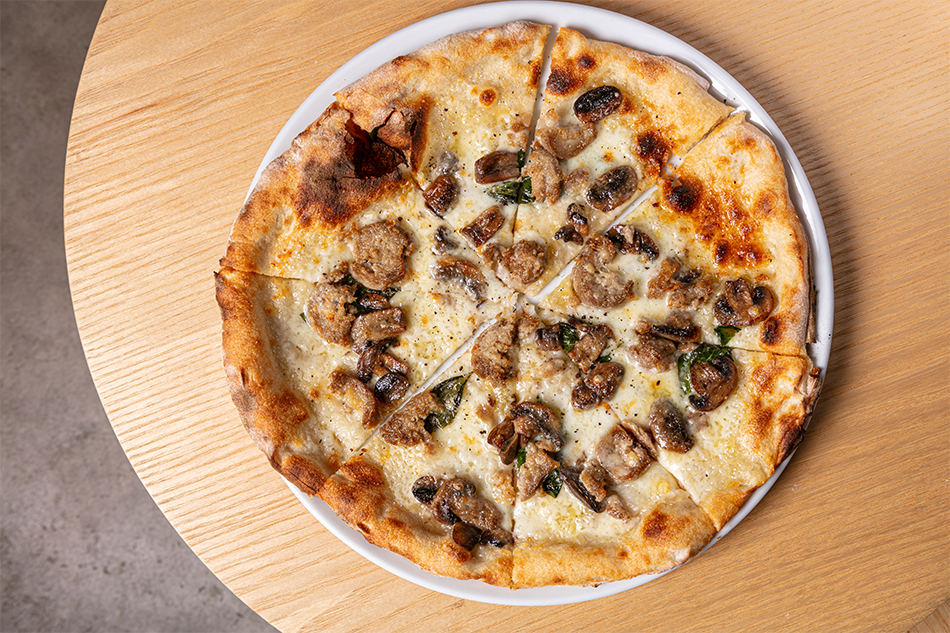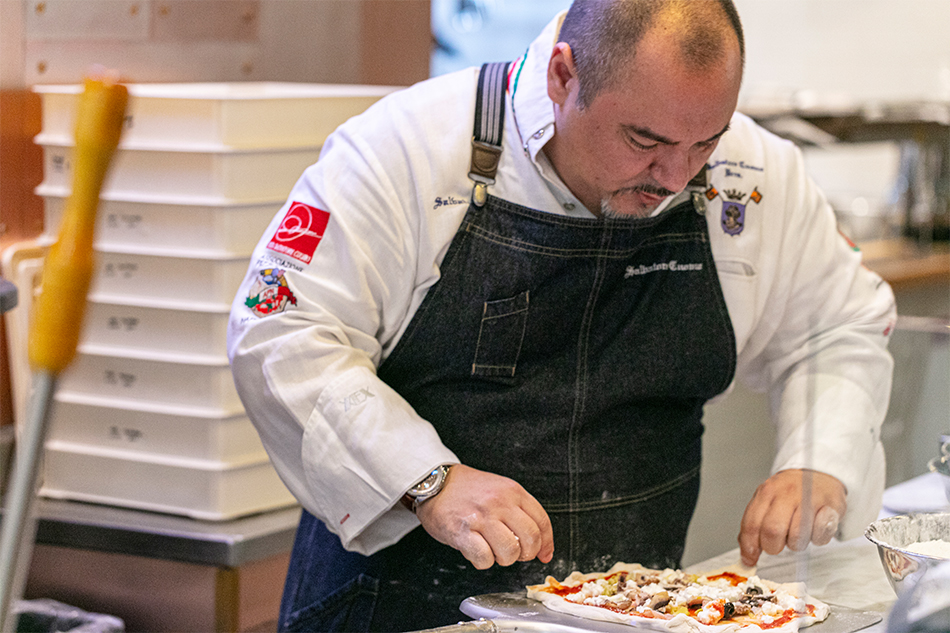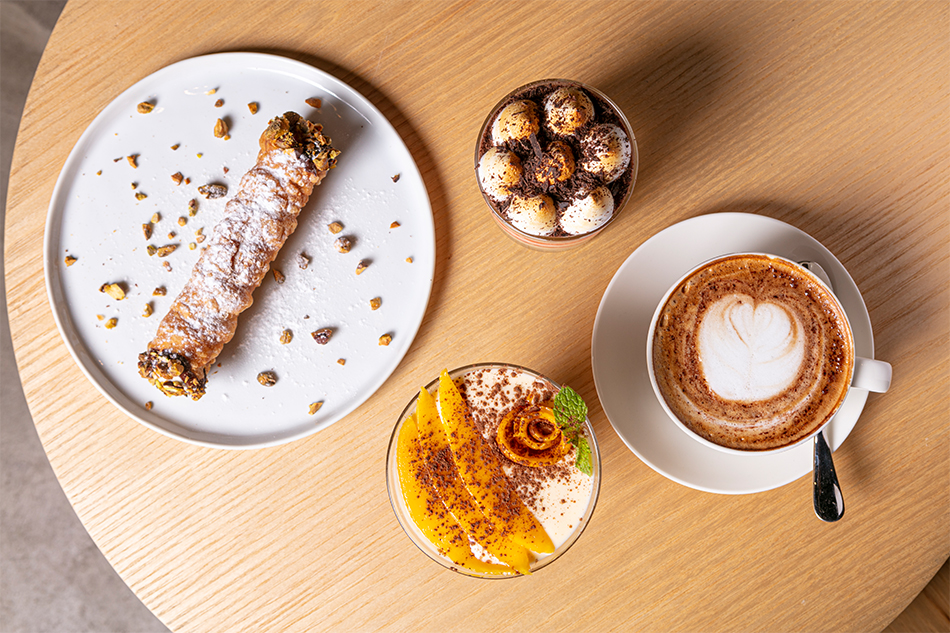Salvatore Cuomo was a pizza delivery boy before he started making pizzas at age 10 | ABS-CBN

Welcome, Kapamilya! We use cookies to improve your browsing experience. Continuing to use this site means you agree to our use of cookies. Tell me more!
Salvatore Cuomo was a pizza delivery boy before he started making pizzas at age 10
Salvatore Cuomo was a pizza delivery boy before he started making pizzas at age 10
Troy Barrios
Published Aug 05, 2019 05:24 PM PHT
|
Updated Aug 05, 2019 07:12 PM PHT
When he was nine, the boy who would grow up to become Salvatore Cuomo, the great pizzaiolo (artisanal pizza maker), would deliver pizza around the ancient city of Naples. He would walk through cobblestone streets, past crumbling churches and busy piazzas, to bring the freshly baked pies to his uncle’s clients. A few regulars who lived on the top floors of ancient apartment buildings, some a few centuries old, would lower wicker baskets by rope for their pizzas. Clearly, from his earliest years, Cuomo’s fate was linked to his native city and its greatest creation, the Pizza Napoletana.
When he was nine, the boy who would grow up to become Salvatore Cuomo, the great pizzaiolo (artisanal pizza maker), would deliver pizza around the ancient city of Naples. He would walk through cobblestone streets, past crumbling churches and busy piazzas, to bring the freshly baked pies to his uncle’s clients. A few regulars who lived on the top floors of ancient apartment buildings, some a few centuries old, would lower wicker baskets by rope for their pizzas. Clearly, from his earliest years, Cuomo’s fate was linked to his native city and its greatest creation, the Pizza Napoletana.
You may also like:
You may also like:
Born to an Italian father and Japanese mother, the young Cuomo was just shy of ten when he announced that he didn’t want to go to school any more. His mother sent him to his uncle’s pizzeria to learn the craft of the pizzaiolo. Located near a busy fish market, the pizzeria was a very traditional one that produced only a thousand pizzas a day in two variants: Marinara, named after the 19th century seamen’s wives who made this pizza for the husbands returning from fishing expeditions in the Bay of Naples, and Margherita, created in honor of the Italian queen, Margherita of Savoy. Sometimes a fisherman would bring some freshly-caught fish to be used as toppings. The rugged, salt-of-the-earth character of the pizzeria and its denizens appealed deeply to Cuomo. “I didn’t think of it as a job at the time,” he says. “It was a bit of an adventure, a reason to escape from school.”
Born to an Italian father and Japanese mother, the young Cuomo was just shy of ten when he announced that he didn’t want to go to school any more. His mother sent him to his uncle’s pizzeria to learn the craft of the pizzaiolo. Located near a busy fish market, the pizzeria was a very traditional one that produced only a thousand pizzas a day in two variants: Marinara, named after the 19th century seamen’s wives who made this pizza for the husbands returning from fishing expeditions in the Bay of Naples, and Margherita, created in honor of the Italian queen, Margherita of Savoy. Sometimes a fisherman would bring some freshly-caught fish to be used as toppings. The rugged, salt-of-the-earth character of the pizzeria and its denizens appealed deeply to Cuomo. “I didn’t think of it as a job at the time,” he says. “It was a bit of an adventure, a reason to escape from school.”
Soon, he was begging to be taught how to make dough. “You’re just a kid!” was his uncle’s initial reaction, though he soon relented. “The first time I made dough, my uncle said a vulgar word and threw it away,” Cuomo says with a grin. “That’s how it was. If you made a mistake, they don’t tell you [what you did wrong].” It takes 30 years for a pizzaiolo to perfect the art of pizza making. Today, there is no doubt that Cuomo is a master of the art, with a feel for dough that is almost instinctive.
Soon, he was begging to be taught how to make dough. “You’re just a kid!” was his uncle’s initial reaction, though he soon relented. “The first time I made dough, my uncle said a vulgar word and threw it away,” Cuomo says with a grin. “That’s how it was. If you made a mistake, they don’t tell you [what you did wrong].” It takes 30 years for a pizzaiolo to perfect the art of pizza making. Today, there is no doubt that Cuomo is a master of the art, with a feel for dough that is almost instinctive.
Pizza, the treasure of Naples
Pizza, the treasure of Naples
In Naples, pizza is not just food. It’s an icon and a birthright. Thin and supple, with deep flavor and tender structure, and every slice of Neapolitan pizza holds within it the essential flavors of the city. It evokes the green slopes of Mount Vesuvius where plump tomatoes for the topping grows, the marshlands of Campania where the buffaloes that produce mozzarella graze, and the hillside groves from where arise the fragrant olive oil.
In Naples, pizza is not just food. It’s an icon and a birthright. Thin and supple, with deep flavor and tender structure, and every slice of Neapolitan pizza holds within it the essential flavors of the city. It evokes the green slopes of Mount Vesuvius where plump tomatoes for the topping grows, the marshlands of Campania where the buffaloes that produce mozzarella graze, and the hillside groves from where arise the fragrant olive oil.
ADVERTISEMENT
Its process is tightly controlled by the Associazione Verace Pizza Napoletana (AVPN). To make real Neapolitan pizza, only specific ingredients must be used, from the type of flour and yeast, to the source of tomatoes and olive oil. And the correct techniques must be practiced. UNESCO recognizes four phases of Neapolitan pizza making, each phase with its own techniques. Most challenging of all, there is no one recipe for Neapolitan pizza, so every pizzaiolo must practice until they can make pizza correctly by feel. This is why it takes so long to learn the art of pizza making.
Its process is tightly controlled by the Associazione Verace Pizza Napoletana (AVPN). To make real Neapolitan pizza, only specific ingredients must be used, from the type of flour and yeast, to the source of tomatoes and olive oil. And the correct techniques must be practiced. UNESCO recognizes four phases of Neapolitan pizza making, each phase with its own techniques. Most challenging of all, there is no one recipe for Neapolitan pizza, so every pizzaiolo must practice until they can make pizza correctly by feel. This is why it takes so long to learn the art of pizza making.
“The secret is in the hands,” explains Cuomo. Unlike cooking where it’s possible to adjust the recipe by taste, pizza is a tactile process. You cannot taste the dough; you can only understand it by touch. “Your hands must be able to tell you what state your dough is in. Unless you can have this connection with the dough, you can never make good pizza,” says Cuomo.
“The secret is in the hands,” explains Cuomo. Unlike cooking where it’s possible to adjust the recipe by taste, pizza is a tactile process. You cannot taste the dough; you can only understand it by touch. “Your hands must be able to tell you what state your dough is in. Unless you can have this connection with the dough, you can never make good pizza,” says Cuomo.
In his quest to become a pizzaiolo, Cuomo discovered a lifelong passion. “This is what I realized, that this pizza is something that comes to me from my uncle, from the father of my uncle, from the father of the father of uncle, and so forth, in a line going back in history. It is my heritage.”
In his quest to become a pizzaiolo, Cuomo discovered a lifelong passion. “This is what I realized, that this pizza is something that comes to me from my uncle, from the father of my uncle, from the father of the father of uncle, and so forth, in a line going back in history. It is my heritage.”
Ironically, his destiny brought him to Asia. His father had opened a restaurant in Chiba prefecture in Japan, and the teenaged Cuomo soon followed to help. By 1992, he had opened his first pizzeria in Japan and realized that the Japanese were familiar only with mainstream “American-style” pizza. So he resolved to introduce real Neapolitan pizza to that country. He was so successful that Japanese media dubbed him a “gift from Naples.” Today, he has a restaurant empire of 77 establishments in Japan, Taiwan, Korea, Shanghai, and Manila.
Ironically, his destiny brought him to Asia. His father had opened a restaurant in Chiba prefecture in Japan, and the teenaged Cuomo soon followed to help. By 1992, he had opened his first pizzeria in Japan and realized that the Japanese were familiar only with mainstream “American-style” pizza. So he resolved to introduce real Neapolitan pizza to that country. He was so successful that Japanese media dubbed him a “gift from Naples.” Today, he has a restaurant empire of 77 establishments in Japan, Taiwan, Korea, Shanghai, and Manila.
Salvatore in Manila
Salvatore in Manila
Salvatore Cuomo’s newest restaurant is Salvatore Cuomo Café in Podium Mall. It’s a stylish, laid back space with a fresh, vibrant aesthetic that feels like an easy escape from the noise and stress of city life.
Salvatore Cuomo’s newest restaurant is Salvatore Cuomo Café in Podium Mall. It’s a stylish, laid back space with a fresh, vibrant aesthetic that feels like an easy escape from the noise and stress of city life.
Here, Neapolitan pizza takes center stage with its traditional thin, almost-soggy crust topped with such temptations as smoked ham and artichoke; porchetta, bacon, and salami. A golden calzone is stuffed with forest ham, basil, ricotta, and provolone. And Cuomo is proud to present pan pizza, which he says is very traditional in Naples, with beautifully charred edges. This comes in such variants as eggplant parmigiana, Neapolitan ragout, or affumicato with sausage, smoked chicken, ribs, and cheese. There are enough selections of pizzas and pastas to make choosing a challenge.
Here, Neapolitan pizza takes center stage with its traditional thin, almost-soggy crust topped with such temptations as smoked ham and artichoke; porchetta, bacon, and salami. A golden calzone is stuffed with forest ham, basil, ricotta, and provolone. And Cuomo is proud to present pan pizza, which he says is very traditional in Naples, with beautifully charred edges. This comes in such variants as eggplant parmigiana, Neapolitan ragout, or affumicato with sausage, smoked chicken, ribs, and cheese. There are enough selections of pizzas and pastas to make choosing a challenge.
In addition to pizza, Cuomo created a menu that reflects the duality of his Italian-Japanese heritage, and it is his simplest dishes that are the most sublime. A rustic Tomato Salad has yellow, orange, and cherry tomatoes so juicy and ripe they barely need a whisk of dressing.
In addition to pizza, Cuomo created a menu that reflects the duality of his Italian-Japanese heritage, and it is his simplest dishes that are the most sublime. A rustic Tomato Salad has yellow, orange, and cherry tomatoes so juicy and ripe they barely need a whisk of dressing.
The Cacio e Pepe is gloriously, effortlessly delicious with just a dusting of black pepper, pecorino and Grana Padano cheeses. A battered Fried Squid and Shrimp is light in texture, deep in flavor. And then there are spectacular dishes like the rather sexy homemade Porchetta or the Grilled Ribs cooked sous vide. Everything goes delightfully with wine.
The Cacio e Pepe is gloriously, effortlessly delicious with just a dusting of black pepper, pecorino and Grana Padano cheeses. A battered Fried Squid and Shrimp is light in texture, deep in flavor. And then there are spectacular dishes like the rather sexy homemade Porchetta or the Grilled Ribs cooked sous vide. Everything goes delightfully with wine.
And now we come to the crux of the matter, for as colorful and intriguing as Cuomo’s story may be, the real pleasure is in the dining. To dine at Salvatore Cuomo’s is to be infused with a cozy delight. Perhaps this is because the chef, who has been featured by Anthony Bourdain and who got UNESCO to list Neapolitan pizzaiolos among the world’s great intangible cultural treasures—this man with such impressive credentials insists that his greatest reward is in giving happiness to his guests. “It’s the look on their faces when they eat. If they are happy, I will know, and that is my biggest satisfaction.”
And now we come to the crux of the matter, for as colorful and intriguing as Cuomo’s story may be, the real pleasure is in the dining. To dine at Salvatore Cuomo’s is to be infused with a cozy delight. Perhaps this is because the chef, who has been featured by Anthony Bourdain and who got UNESCO to list Neapolitan pizzaiolos among the world’s great intangible cultural treasures—this man with such impressive credentials insists that his greatest reward is in giving happiness to his guests. “It’s the look on their faces when they eat. If they are happy, I will know, and that is my biggest satisfaction.”
Salvatore Cuomo makes fantastic pizzas, but what he’s really serving is joy.
Salvatore Cuomo makes fantastic pizzas, but what he’s really serving is joy.
Salvatore Cuomo Café, G/F The Podium Mall, ADB Avenue, Ortigas Center, Mandaluyong City, FB @salvatorecuomocafe, www.saltavorecuomoph.com
Photographs by Jar Concengco
ADVERTISEMENT
ADVERTISEMENT












